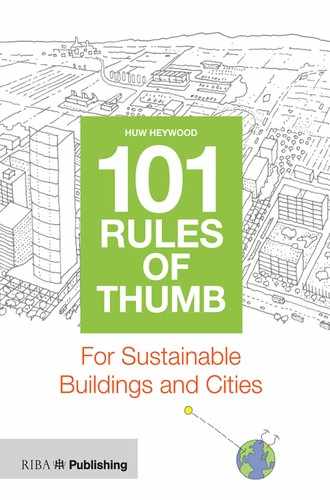Introduction, and what the Rules of Thumb are for
Since its birth 4.5 billion years ago, our planet has survived much more than we humans have thrown at it (and removed from it) in the last mere 200,000 years. Geologically speaking, we now live in the Holocene epoch–an era that began around 11,700 years ago, and which has witnessed both the development of civilisations and the dawn of cities. The emerging message is that it is not the fragility of the planet but rather the risk we pose to ourselves, our vulnerability resulting from our own actions in the environment, which results in the need for sustainable thought and action. Sustainability is a large, complex topic, but at its heart is the simple truth that everything we humans need to survive and thrive is provided by the natural world, meaning that we must find a productive balance with nature if we are to endure. In a sense, this book is about the global concerns of ecosystem destruction, species loss, climate change, food and energy supply, pollution and waste which dominate sustainability literature, but it does not dwell on the negative: the rules of thumb seek to provide a positive framework for good decisions.
The multidimensional nature of sustainability represents both its attraction and its difficulty. Phrases that we have become used to, and which are often used interchangeably, include ‘ecological’, ‘green’, ‘environmental’, ‘eco-friendly’ and ‘bioclimatic design’, and we often hear buildings and cities described as ‘environmentally sustainable’. But a building or a city could be designed with strong environmental/ecological credentials (eg, achieving low energy use, incorporating sustainable resources, addressing human comfort) but still be unsustainable because it is rejected by society, generates waste and pollution, is too complex to operate or too costly to run. To design sustainable built environments we need to be constantly and holistically mindful of the people we are designing for (now and into the future), of the places in which we are designing and of the nature of our planet. In this way, those with a passion to create beautiful and enduring buildings and spaces will be the ones who find innovative and lasting solutions for the way we live with our planet. The rules of thumb are for those who wish to take seriously their ethical responsibility to commission, design, operate and inhabit our current and future buildings and cities sustainably.
This book is structured in five chapters illustrated with diagrams, as was the first book in the series. Chapters 1 to 4 set out the rules of thumb and Chapter 5 shows how those rules might be applied strategically, and does so within the context of an important emerging idea: that we should not simply be seeking to do less harm but rather pursuing positive outcomes for the environment, for ecosystems and for people. The illustrated rules of thumb in Chapters 1 to 5 are, if you like, the book; a picture is, after all, worth a thousand words. Then, a narrative bibliography explains the book, providing the background research and references to key texts, as well as ideas for further sources of information and this author’s commentary.
As sustainability is an ever-evolving, trans-disciplinary subject encompassing a hugely diverse range of ideas and topics, the reader will find in the following chapters reference to the chemistry and ecology of building materials, the study of soundscape, the habits of owls, biomimetics, social justice and equity, the earth sciences, human physiology (how humans work), building physics (how buildings work), urban climatology, hydrology, health, the processes of design and urban agriculture, to name just a few.
Nonetheless, the subjects that sit under the umberella of sustainability are all connected, and this is reflected in the attempt to show, via cross-referencing at the end of each rule, where particulatly strong links exist. It is hoped that the reader finds this a useful device because, in the true spirit of sustainable thinking, it emerges that in fact a powerful connection exists between each and every one of the rules of thumb presented in the following pages.
